
Image source: http:// okinawa.nict.go.jp/EN/VM/img/n03.gif
Radio Communication
The invention of radio communication stems from the need to transmit information. Transmitting human voice is seen as more favorable due to the rate at which words or data can be transferred. Communication via Morse code or written letter is limited in the speed of data transfer.
Now, how can human voice be transmitted? Transmitting human voice involves converting sound into electricity and then propagating that electromagnetic signal through an antenna that can be received by an antenna on the receiving end. The antenna size and length plays a huge role in how adequately the message is received. The physical size and configuration of the antenna depends primarily on the frequency of the transmitted signal.
The transfer of electromagnetic waves from transmitter to receiver requires the antenna to be longer than 1/10 of the wavelength for near perfect transmission.
Antenna size to transmit humans' voice.
Let's see how big of an antenna we would need to adequately transfer human voice directly. Human voice is on average 4 kHz in frequency.
We can use the wave length formula to find the appropriate antenna size; where the wave length 


This means that we would need and antenna 7,500 meters long!
So this begs the question: What is a good frequency in which we can easily transfer data?
First, what are the advantages and disadvantages of low and high frequencies?
Low Frequency:
- Farther wave propagation
- Slower Data Transmission
- Larger Antenna
High Frequency:
- Waves travel smaller distances
- Higher Data Transmission
- Smaller Antenna
Radio frequencies meet a middle ground on these features. The frequency is high enough to have a small antenna but low enough to travel far distances. AM radio waves travel around 300-400 miles with frequencies around 1 MHz.
This means that we would need and antenna 30 meters long to perfectly receive AM broadcast.
Most cars have AM radio receivers and the antennas are not 30 meters long. To explain, the antenna should be tenth of the wavelength, but the exact ratios don't matter so much. The antenna will be inefficient, but it works for both sending and receiving. If you can detect the signal, of course you can amplify and filter it as much as you want. A couple feet does the trick.
How can we increase the frequency of human voice to be that of radio?
Modulation
This is where the idea of modulation comes into play. Modulation is taking a signal, say human voice, and have it ride on top of a radio wave. The figure below shows amplitude modulation
The message )
)
)
)
)

Now we can remove the carrier signal on the receiving end and we have back our original signal!
Works Cited
Proakis, John G. Fundamentals of Communication Systems. 2nd ed., Pearson., pp. 117-126


If you would like future votes from us, please be sure to add credit for your images on this post, and references to the material you've written about!
Just did. I was having difficultly the first time uploading it. Half of the text got deleted so I rewrote a good portion of the article.
Looks good. Did you create the images yourself?
All of them except the first one. The graphs were made using in Latex using Tikz.